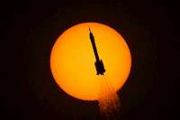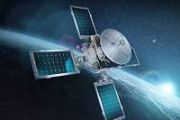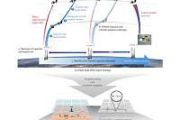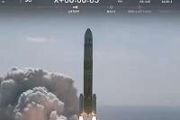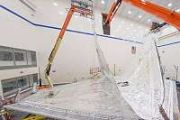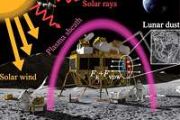
Copernical Team
China boosts Lunar and Mars mission capabilities with advanced Long March rockets
 China's Long March 10, the next-generation manned launch vehicle, is set to significantly enhance the nation's lunar mission capabilities, increasing its lunar transfer orbit payload capacity from 8.2 tonnes to an impressive 27 tonnes. This development was announced by Long Lehao, a senior rocket designer at the China Academy of Launch Vehicle Technology (CALT).
Long March 10 is designed t
China's Long March 10, the next-generation manned launch vehicle, is set to significantly enhance the nation's lunar mission capabilities, increasing its lunar transfer orbit payload capacity from 8.2 tonnes to an impressive 27 tonnes. This development was announced by Long Lehao, a senior rocket designer at the China Academy of Launch Vehicle Technology (CALT).
Long March 10 is designed t Space-time crystals enable advances in optical materials
 Photonic time crystals, materials with consistent spatial composition but periodically varying properties over time, offer innovative pathways for optical information processing. These materials can modulate and amplify light's spectral composition, enabling advanced functionality. "This gives us new degrees of freedom but also poses a lot of challenges," said Professor Carsten Rockstuhl from Ka
Photonic time crystals, materials with consistent spatial composition but periodically varying properties over time, offer innovative pathways for optical information processing. These materials can modulate and amplify light's spectral composition, enabling advanced functionality. "This gives us new degrees of freedom but also poses a lot of challenges," said Professor Carsten Rockstuhl from Ka Space42 and ICEYE partner to manufacture SAR satellites in UAE
 Space42 (ADX: SPACE42), a leading UAE-based AI-driven SpaceTech firm, and ICEYE, a global authority in Synthetic Aperture Radar (SAR) satellite operations, have announced a joint venture to produce SAR satellites in the UAE. This partnership builds on their collaboration, highlighted by the successful launch of the UAE's first SAR satellite, Foresight-1, in August 2024.
The joint venture f
Space42 (ADX: SPACE42), a leading UAE-based AI-driven SpaceTech firm, and ICEYE, a global authority in Synthetic Aperture Radar (SAR) satellite operations, have announced a joint venture to produce SAR satellites in the UAE. This partnership builds on their collaboration, highlighted by the successful launch of the UAE's first SAR satellite, Foresight-1, in August 2024.
The joint venture f Webb Telescope unveils unexpected details in Spiderweb Protocluster
 A team of international astronomers has used the NASA/ESA/CSA James Webb Space Telescope to uncover previously hidden galaxies in the Spiderweb protocluster. These findings challenge earlier assumptions about the role of gravitational interactions in dense cosmic regions, offering fresh insights into galaxy formation within these large-scale structures.
The Spiderweb protocluster, a well-d
A team of international astronomers has used the NASA/ESA/CSA James Webb Space Telescope to uncover previously hidden galaxies in the Spiderweb protocluster. These findings challenge earlier assumptions about the role of gravitational interactions in dense cosmic regions, offering fresh insights into galaxy formation within these large-scale structures.
The Spiderweb protocluster, a well-d Robotics microbiology and agriculture dominate ISS research this month
 The International Space Station (ISS) wrapped up the week with a focus on robotics, microbiology, and space agriculture as the Expedition 72 crew tackled an intensive schedule of scientific investigations and maintenance. Preparations for an upcoming spacewalk and continued work on the station's systems rounded out the crew's activities.
NASA astronaut and station commander Suni Williams c
The International Space Station (ISS) wrapped up the week with a focus on robotics, microbiology, and space agriculture as the Expedition 72 crew tackled an intensive schedule of scientific investigations and maintenance. Preparations for an upcoming spacewalk and continued work on the station's systems rounded out the crew's activities.
NASA astronaut and station commander Suni Williams c BepiColombo achieves milestone with mid-infrared observations of Mercury
 On December 1, 2024, the European Space Agency's BepiColombo mission completed its fifth flyby of Mercury, marking a historic first by capturing the planet in mid-infrared light. The unprecedented images provide fresh insights into the temperature and mineral composition of Mercury's cratered surface.
Mercury, the least-explored terrestrial planet in the Solar System, has only been visited
On December 1, 2024, the European Space Agency's BepiColombo mission completed its fifth flyby of Mercury, marking a historic first by capturing the planet in mid-infrared light. The unprecedented images provide fresh insights into the temperature and mineral composition of Mercury's cratered surface.
Mercury, the least-explored terrestrial planet in the Solar System, has only been visited A mission design to extend the life of space telescopes
 The longevity of space telescopes is improving as researchers devise serviceable designs for future observatories. Inspired by current missions like the James Webb Space Telescope (JWST) and the European Space Agency's Gaia, a new servicing plan has been developed to ensure these powerful tools can operate for longer periods.
"Although the next generation of large space telescopes are bein
The longevity of space telescopes is improving as researchers devise serviceable designs for future observatories. Inspired by current missions like the James Webb Space Telescope (JWST) and the European Space Agency's Gaia, a new servicing plan has been developed to ensure these powerful tools can operate for longer periods.
"Although the next generation of large space telescopes are bein Plextek's cutting-edge mmWave technology for space operations and sensing
 Plextek, a leading consultancy recognized for its expertise in low Size, Weight, and Power (SWaP) sensing technology, has published its latest innovation in the field of in-orbit space operations and sensing. In their technical paper titled "Sensing in Space" Plextek showcases groundbreaking mmWave radar technology, designed to improve the safety and reliability of future space and satellite missions.
Plextek, a leading consultancy recognized for its expertise in low Size, Weight, and Power (SWaP) sensing technology, has published its latest innovation in the field of in-orbit space operations and sensing. In their technical paper titled "Sensing in Space" Plextek showcases groundbreaking mmWave radar technology, designed to improve the safety and reliability of future space and satellite missions. What is the universe expanding into if it's already infinite?
 When you bake a loaf of bread or a batch of muffins, you put the dough into a pan. As the dough bakes in the oven, it expands into the baking pan. Any chocolate chips or blueberries in the muffin batter become farther away from each other as the muffin batter expands.
The expansion of the universe is, in some ways, similar. But this analogy gets one thing wrong - while the dough expands in
When you bake a loaf of bread or a batch of muffins, you put the dough into a pan. As the dough bakes in the oven, it expands into the baking pan. Any chocolate chips or blueberries in the muffin batter become farther away from each other as the muffin batter expands.
The expansion of the universe is, in some ways, similar. But this analogy gets one thing wrong - while the dough expands in Mercury observed in thermal infrared for the first time
 Mercury, the smallest and innermost planet in the solar system, continues to intrigue planetary researchers with its unique composition and structure, which differ significantly from Earth's Moon despite surface similarities. BepiColombo, a collaborative mission by the European Space Agency (ESA) and Japan Aerospace Exploration Agency (JAXA), aims to resolve these mysteries. Launched in 2018, th
Mercury, the smallest and innermost planet in the solar system, continues to intrigue planetary researchers with its unique composition and structure, which differ significantly from Earth's Moon despite surface similarities. BepiColombo, a collaborative mission by the European Space Agency (ESA) and Japan Aerospace Exploration Agency (JAXA), aims to resolve these mysteries. Launched in 2018, th 











